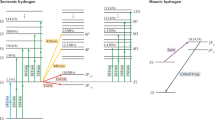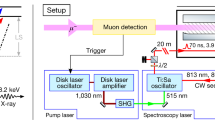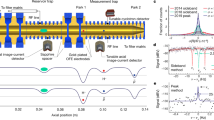Abstract
Elastic electron–proton scattering (e–p) and the spectroscopy of hydrogen atoms are the two methods traditionally used to determine the proton charge radius, rp. In 2010, a new method using muonic hydrogen atoms1 found a substantial discrepancy compared with previous results2, which became known as the ‘proton radius puzzle’. Despite experimental and theoretical efforts, the puzzle remains unresolved. In fact, there is a discrepancy between the two most recent spectroscopic measurements conducted on ordinary hydrogen3,4. Here we report on the proton charge radius experiment at Jefferson Laboratory (PRad), a high-precision e–p experiment that was established after the discrepancy was identified. We used a magnetic-spectrometer-free method along with a windowless hydrogen gas target, which overcame several limitations of previous e–p experiments and enabled measurements at very small forward-scattering angles. Our result, rp = 0.831 ± 0.007stat ± 0.012syst femtometres, is smaller than the most recent high-precision e–p measurement5 and 2.7 standard deviations smaller than the average of all e–p experimental results6. The smaller rp we have now measured supports the value found by two previous muonic hydrogen experiments1,7. In addition, our finding agrees with the revised value (announced in 2019) for the Rydberg constant8—one of the most accurately evaluated fundamental constants in physics.
This is a preview of subscription content, access via your institution
Access options
Access Nature and 54 other Nature Portfolio journals
Get Nature+, our best-value online-access subscription
$29.99 / 30 days
cancel any time
Subscribe to this journal
Receive 51 print issues and online access
$199.00 per year
only $3.90 per issue
Buy this article
- Purchase on Springer Link
- Instant access to full article PDF
Prices may be subject to local taxes which are calculated during checkout




Similar content being viewed by others
Data availability
The raw data from this experiment are archived in Jefferson Laboratory’s mass storage silo.
Code availability
All computer codes used for data analysis and simulation are archived in Jefferson Laboratory’s mass storage silo.
References
Pohl, R. et al. The size of the proton. Nature 466, 213–216 (2010).
Mohr, P. J., Taylor, B. N. & Newell, D. B. CODATA recommended values of the fundamental physical constants: 2006. Rev. Mod. Phys. 80, 633–730 (2008).
Beyer, A. et al. The Rydberg constant and proton size from atomic hydrogen. Science 358, 79–85 (2017).
Fleurbaey, H. New measurement of the 1S–3S transition frequency of hydrogen: contribution to the proton charge radius puzzle. Phys. Rev. Lett. 120, 183001 (2018).
Bernauer, J. C. et al. High-precision determination of the electric and magnetic form factors of the proton. Phys. Rev. Lett. 105, 242001 (2010).
Mohr, P. J., Newell, D. B. & Taylor, B. N. CODATA recommended values of the fundamental physical constants: 2014. J. Phys. Chem. Ref. Data 45, 043102 (2016).
Antognini, A. et al. Proton structure from the measurement of 2S–2P transition frequencies of muonic hydrogen. Science 339, 417–420 (2013).
Mohr, P. J., Newell, D. B. & Taylor, B. N. CODATA recommended values of the fundamental physical constants: 2018. http://physics.nist.gov/constants (2019).
Hasan, N. et al. Computing the nucleon charge and axial radii directly at Q 2 = 0 in lattice QCD. Phys. Rev. D 97, 034504 (2018).
Mohr, P. J., Taylor, B. N. & Newell, D. B. CODATA recommended values of the fundamental physical constants: 2010. Rev. Mod. Phys. 84, 1527–1605 (2012).
Carlson, C. E. The proton radius puzzle. Prog. Part. Nucl. Phys. 82, 59–77 (2015).
Liu, Y. S. & Miller, G. A. Validity of the Weizsäcker–Williams approximation and the analysis of beam dump experiments: production of an axion, a dark photon, or a new axial-vector boson. Phys. Rev. D 96, 016004 (2017).
Miller, G. A. Defining the proton radius: a unified treatment. Phys. Rev. C 99, 035202 (2019).
Miller, G. A. Proton polarizability contribution: muonic hydrogen Lamb shift and elastic scattering. Phys. Lett. B 718, 1078–1082 (2013).
Antognini, A. et al. Theory of the 2S–2P Lamb shift and 2S hyperfine splitting in muonic hydrogen. Ann. Phys. 331, 127–145 (2013).
Lee, G., Arrington, J. R. & Hill, R. J. Extraction of the proton radius from electron–proton scattering data. Phys. Rev. D 92, 013013 (2015).
Higinbotham, D. W. et al. Proton radius from electron scattering data. Phys. Rev. C 93, 055207 (2016).
Griffioen, K., Carlson, C. & Maddox, S. Consistency of electron scattering data with a small proton radius. Phys. Rev. C 93, 065207 (2016).
Gasparian, A. et al. High Precision Measurement of the Proton Charge Radius. Proposal to Jefferson Lab, PAC-38 C12-11-106 https://www.jlab.org/exp_prog/proposals/11/PR12-11-106.pdf (2011).
Gasparian, A. A high performance hybrid electromagnetic calorimeter at Jefferson Lab. In Proc. 11th Int. Conf. on Calorimetry in Particle Physics (eds Cecchi, C. et al.) 109–115 (World Scientific, 2005).
Mecking, B. et al. The CEBAF large acceptance spectrometer (CLAS). Nucl. Instrum. Meth. A 503, 513–553 (2003).
Agostinelli, S. et al. GEANT4: a simulation toolkit. Nucl. Instrum. Meth. A 506, 250–303 (2003).
Akushevich, I., Gao, H., Ilyichev, A. & Meziane, M. Radiative corrections beyond the ultra relativistic limit in unpolarized ep elastic and Møller scatterings for the PRad experiment at Jefferson Laboratory. Eur. Phys. J. A 51, 1 (2015).
Gramolin, A. V. et al. A new event generator for the elastic scattering of charged leptons on protons. J. Phys. G Nucl. Phys. 41, 115001 (2014).
Christy, M. E. & Bosted, P. E. Empirical fit to precision inclusive electron–proton cross-sections in the resonance region. Phys. Rev. C 81, 055213 (2010).
Kelly, J. J. Simple parametrization of nucleon form factors. Phys. Rev. C 70, 068202 (2004).
Venkat, S., Arrington, J., Miller, G. A. & Zhan, X. Realistic transverse images of the proton charge and magnetic densities. Phys. Rev. C 83, 015203 (2011).
Higinbotham, D. W. & McClellan, R. E. How analytic choices can affect the extraction of electromagnetic form factors from elastic electron scattering cross section data. Preprint at https://arxiv.org/abs/1902.08185 (2018).
Yan, X. et al. Robust extraction of the proton charge radius from electron–proton scattering data. Phys. Rev. C 98, 025204 (2018).
Alarcón, J. M., Higinbotham, D. W., Weiss, C. & Ye, Z. Proton charge radius from electron scattering data using dispersively improved chiral effective field theory. Phys. Rev. C 99, 044303 (2019).
Acknowledgements
This work was funded in part by the US National Science Foundation (NSF MRI PHY-1229153) and by the US Department of Energy (contract number DE-FG02-03ER41231), including contract number DE-AC05-06OR23177, under which Jefferson Science Associates, LLC operates the Thomas Jefferson National Accelerator Facility. We thank the staff of Jefferson Laboratory for their support throughout the experiment. We are also grateful to all grant agencies for providing funding support to the authors throughout this project. We acknowledge discussions about radiative corrections with A. Afanasev, I. Akushevich, A. V. Gramolin and O. Tomalak. We thank S. Danagoulian for helping to restore the light monitoring system of HyCal. We also thank S. Javalkar for help with a beam halo study.
Author information
Authors and Affiliations
Contributions
A.G. is the spokesperson of the experiment. H.G., D. Dutta and M.K. are co-spokespersons of the experiment. A.G. developed the initial concepts of the experiment. A.G., H.G., D. Dutta and M.K designed and proposed the experiment. The entire PRad collaboration constructed the experiment and worked on the data collection. The COMSOL simulation of the target was built by Y.Z. The Monte Carlo simulation was built and validated by C. Peng, C.G., W.X. and X.B. with input from numerous other members of the collaboration. Calibrations were carried out by W.X., M.L., X.B., C. Peng, L.Y. and X.Y., with input from I.L. Analysis software tools were developed by C. Peng, with input from X.B., M.L., I.L., L.Y., W.X. and X.Y. The data analysis was carried out by W.X., C. Peng, X.B., M.L. and C.G., with input from A.G., H.G., D. Dutta, M.K., N.L., E.P., X.Y., D.W.H., L.Y. and M.L.K. All authors reviewed the manuscript.
Corresponding authors
Ethics declarations
Competing interests
The authors declare no competing interests.
Additional information
Publisher’s note Springer Nature remains neutral with regard to jurisdictional claims in published maps and institutional affiliations.
Peer review information Nature thanks Krzysztof Pachucki and the other, anonymous, reviewer(s) for their contribution to the peer review of this work.
Supplementary information
Supplementary Information
file contains Supplementary Material, including Supplementary Figures 1-16, Supplementary Table 1 and additional references
Rights and permissions
About this article
Cite this article
Xiong, W., Gasparian, A., Gao, H. et al. A small proton charge radius from an electron–proton scattering experiment. Nature 575, 147–150 (2019). https://doi.org/10.1038/s41586-019-1721-2
Received:
Accepted:
Published:
Issue Date:
DOI: https://doi.org/10.1038/s41586-019-1721-2
This article is cited by
-
Recent Results on Proton Charge Radius and Polarizabilities
Few-Body Systems (2024)
-
Rabi-oscillation spectroscopy of the hyperfine structure of the muonium atom for high-precision determination of the muon mass
Interactions (2024)
-
A glimpse at the inner structure of the proton
Nature (2023)
-
\( \mathcal{O} \)(mα2(Zα)6) contribution to Lamb shift from radiative corrections to the Wichmann-Kroll potential
Journal of High Energy Physics (2023)
-
Data-Driven Extraction of Hadron Radii
Few-Body Systems (2023)
Comments
By submitting a comment you agree to abide by our Terms and Community Guidelines. If you find something abusive or that does not comply with our terms or guidelines please flag it as inappropriate.



